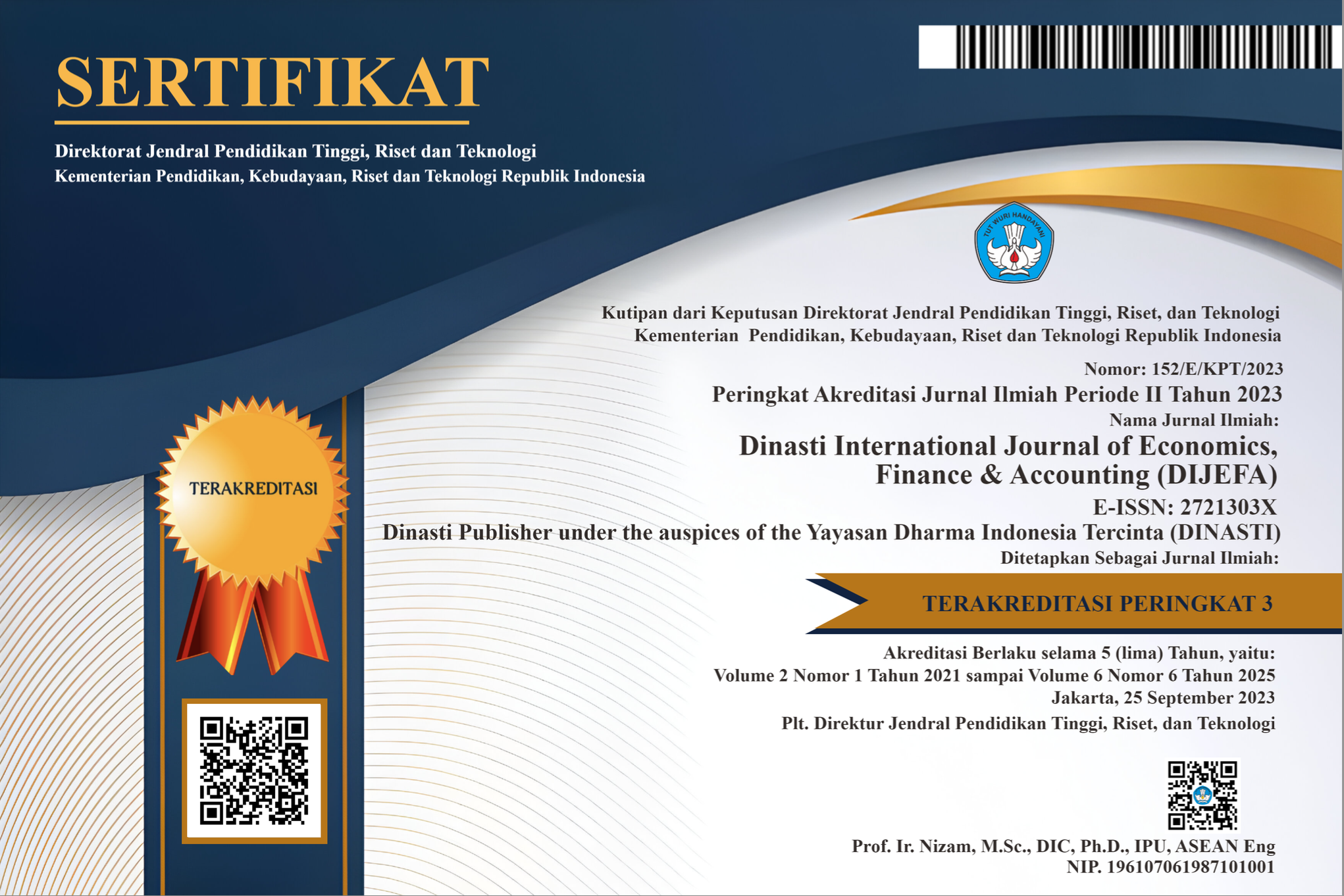Analysis of Sharia Stock Valuation Using The FCFE And Relative Valuation Methods Sector Listed on The Sharia Securities List
DOI:
https://doi.org/10.38035/dijefa.v5i3.2844Keywords:
Stock Valuation, Islamic Stock, Free Cash Flow to Equity (FCFE), Relative Valuation Property Sector, Shariah Listed SecuritiesAbstract
The objective of this study is to analyze the intrinsic value of sharia stocks in the property sector listed on the Sharia Securities List (DES), utilizing two distinct valuation methodologies: free cash flow to equity (FCFE) and relative valuation. The stocks selected for analysis include PT Metropolitan Kentjana Tbk (MKPI), PT Mega Manunggal Property Tbk (MMLP), and PT Pollux Properties Indonesia Tbk (POLL). In this study, the free cash flow to equity (FCFE) method was employed to ascertain the intrinsic value of the shares. This was achieved through the consideration of free cash flow, which was subsequently deducted to account for expenses pertaining to working capital and investment. In contrast, the relative valuation method involved the comparison of the intrinsic value of the shares with financial ratios such as the price-to-earnings ratio (PER) and the price-to-book value (PBV). The aforementioned approach was informed by a fundamental analysis, which involved the examination of macroeconomic conditions, industry conditions, and company conditions. The data was obtained from property companies listed on the Indonesia Sharia Stock Index (ISSI) for the period 2019-2022. The results indicated that the intrinsic value of MKPI stock, as determined by the FCFE method, was Rp. 24,134. This value suggests that the stock is overvalued, given that the market price was Rp. 27,200. The PER method yielded the following results: The intrinsic value of the stock is Rp. 59,461, indicating that it is undervalued. The PBV method yields an intrinsic value of IDR 7,515, indicating that the stock is overvalued. The MMLP Shares are valued using the FCFE method, which yields an intrinsic value of IDR 4,857, indicating that the stock is undervalued as the market price is IDR 298. The PER method yields an intrinsic value of IDR 686, indicating that the stock is undervalued. The intrinsic value of the stock is IDR 893, indicating that it is undervalued. The PBV method yields an intrinsic value of IDR 686, also indicating undervaluation. The POLL stock is undervalued according to the FCFE method, with an intrinsic value of IDR 251. This is due to the market price of IDR 147. Finally, the PER method yields an intrinsic value of IDR 109, indicating that the stock is undervalued. The intrinsic value of IDR 109 indicates that the stock is undervalued. The PBV method yields an intrinsic value of IDR 214, which also indicates undervaluation. In conclusion, the FCFE and Relative Valuation methods can be used to determine the fairness of Islamic stock prices in the property sector.
The data was obtained from property companies listed on the Indonesia Sharia Stock Index (ISSI) for the period 2019-2022. The results indicated that the intrinsic value of MKPI stock, as determined by the FCFE method, was Rp. 24,134. This value suggests that the stock is overvalued, given that the market price was Rp. 27,200. The PER method yielded the following results:
References
Achsien, I. (2013). Investasi Syariah di Pasar Modal: Menggagas Konsep dan Praktek Manajemen Portofolio Syariah, Cet. Kedua. Gramedia Pustaka Utama.
Afriani, E., & Asma, R. (2019). Analisis Valuasi Harga Saham dengan Price Earning Ratio, Free Cash Flow to Equity dan Free Cash Flow to Firm Pada Perusahaan Manufaktur. Jurnal Sains Manajemen Dan Kewirausahaan, 3(2), 111–123.
Al-Zuhaili. (2002). Transaksi Keuangan Kontemporer. Damaskus-Suriah, Dar Al-Fikr, edisi pertama.
Anastasia, N. (2013). Analisis Faktor Fundamental dan Risiko Sistematika Terhadap Harga Saham Properti Di BEJ. Jurnal Akuntansi & Keuangan Vol. 5, No. 2, Nopember 2013: 123 – 132. https://doi.org/https://doi.org/10.9744/jak.5.2.pp.%20123-132
Anoraga, Panji dan Pakarti, P. (2013). Pengantar Pasar Modal, Edisi Revisi. Asdi Mahasatya.
Astuti, L. P. (2013). Penilaian Harga Wajar Saham Pt.Kimia Farma (Persero) Tbk Dan Pt. Indofarma (Persero) Tbk Menjelang Akuisisi,. Jurnal Mix, Volume Iii, No. 2, Juni 2013.
Brown, R. and. (2016). Investment Analysis and Portofolio Management. Mason OH: Thomson (South Western).
Budiman, Rahmat & Darmawan, A. (2018). Analisis Fundamental Harga Saham Perusahaan Dengan Menggunakan Metode Discounted Cash Flow Dan Price Earning Ratio. Jurnal Administrasi Bisnis (Jab)|Vol. 63 No. 1 Oktober 2018.
Damodaran. (2012). Damodaran On Valuation: Security Analysis For Investment And Corporate Finance. John Wiley & Sons Inc.
Dewan Syariah Nasional MUI. (2014). HimpunanFatwa Keuangan Syariah,. Erlangga.
Fahmi, I. (2015). Pengantar Teori Portofolio dan Analisis Investasi. Penerbit Alfabeta.
Fakhruddin, A. T. dan H. M. (2011). Pasar Modal di Indonesia,. Salemba Empat.
Gampito, G., & Melia, Y. (2022). Pengaruh Inflasi dan Nilai Tukar Rupiah Terhadap Harga Saham Perusahaan Property Efek Syariah. I-Finance: A Research Journal on Islamic Finance, 8(1), 34–48. https://doi.org/10.19109/ifinance.v8i1.12558
H, Ismik Kurniaty. Hidayat, Raden Rustam dan Endang, M. G. (2016). Analisis Fundamental Untuk Menilai Kewajaran Harga Saham Dengan Dividend Discount Model (Ddm) Dan Price Earning Ratio (Per) Sebagai Dasar Pengambilan Keputusan Investasi (Studi Pada Subsektor Perbankan Yang.
Hadi, N. (2018). Pasar Modal. Edisi Pertama.
Hartono, J. (2015). Teori Postofolio dan Analisis Investasi (10th ed.). BPFE.
Hartono, J. (2013). Teori Portofolio dan Analisis Investasi.
Hermuningsih, S. (2012). Pengantar Pasar Modal Indonesia,. Yogyakarta UPP STIEM YKPN, 2012.
Indriwan, N. & N. (2023). Analisis Fundamental Untuk Menilai Kewajaran Harga Saham Pada Perusahaan Sektor Energi Yang Terdaftar Di Bei. Journal Of Young Entrepreneurs, Vol. 1, No. 1, Januari 2023, Pages 112-126 E-Issn 2964-8521.
Inggrid, T. (2019). Bisnis dan Investasi Sistem Syari’ah.
Manan, A. (2014). Aspek Hukum dalam Penyelenggaraan Investasi di Pasar Modal Syariah Indonesia,. Kencana.
Martono, H. dan. (2017). Manajemen Keuangan,. Ekonisia.
Muhammad Syafi?I Antonio. (2011). Bank Syariah dari Teori ke Praktik,.
Mulkan dan Herawati. (2018). Valuation Pada Initial Public Offering (Ipo) Bank Brisyariah”. Jurnal SWOT Vol 8, No. 3 2018.
Mulyadi. (2016). Akuntansi Manajemen Edisi Ketiga.
Musdalifa, Sri Mintari, M. N. (2015). Fundamental, Teknikal, Perilaku Investor, dan Return Saham.
Prasetyo, A. H. (2011). Valuasi Perusahaan.
Prowanta, E., & Herlianto, D. (2020). Manajemen Investasi dan Portofolio. Gosyen Publishing.
Pulungan, Rusdi Riduan. Batubara, Maryam & Rahmani, N. A. B. (2023). Analisis Valuasi Saham Syariah Sektor Batubara Menggunakan Metode Fcfe Dan Relative Valuation Dimasa Pandemi Covid-19 Yang Terdaftar Di Issi. Jurnal Akuntansi Dan Pajak, Issn 1412-629x L E-Issn 2579-3055.
Radwan, Samir Abdel Hamid, D. (1996). "Pasar Surat Berharga dan Perannya dalam Pembiayaan Pembangunan. Kairo?: Al- Eqtisadiah", International Institute of Islamic Thought, 1996).
Rusdin. (2018). Pasar Modal: Teori, Masalah, dan Kebijakan dalam Praktek,.
Sari, D. R. dan H. P. (2020). Valuasi Harga Wajar Saham Menggunakan Metode Dividend Discount Model Dan Price To Book Value Ratio (Studi Empiris Pada Perusahaan Sub Sektor Property Dan Real Estate Yang Terdaftar Di Bursa Efek Indonesia Pada Tahun 2016-2019). Sekolah Tinggi Ilmu Ekonomi Indonesia – 2020.
Sunariyah. (2013). Pengantar Pengetahuan Pasar Modal.
Suteja, J., & Gunardi, A. (2016). Manajemen Investasi dan Porofolio. Refika Aditama.
Sutrisno. (2018). Manajemen Keuangan.
Tandelilin, E. (2017). Pasar Modal Manajemen Portofolio & Investasi. PT Kanisus.
Wira, D. (2014). Analisis Fundamental Saham.
Yauwanta, Y. S. (2023). Analisis Fundamental Untuk Memperoleh Nilai Wajar Saham Smdr Dengan Metode Free Cash Flow To Equity Dan Price Earning Ratio. CAKRAWALA – Repositori IMWI |.
Yuliana, I. (2010). Investasi Produk Keuangan Syariah,. UIN-MALIKI PRESS.
Downloads
Published
How to Cite
Issue
Section
License
Copyright (c) 2024 Muhammad Hanafi Hamonangan, Nurlaila, Maryam Batubara

This work is licensed under a Creative Commons Attribution 4.0 International License.
Authors who publish their manuscripts in this journal agree to the following conditions:
- The copyright on each article belongs to the author(s).
- The author acknowledges that the Dinasti International Journal of Economics, Finance & Accounting (DIJEFA) has the right to be the first to publish with a Creative Commons Attribution 4.0 International license (Attribution 4.0 International (CC BY 4.0).
- Authors can submit articles separately, arrange for the non-exclusive distribution of manuscripts that have been published in this journal into other versions (e.g., sent to the author's institutional repository, publication into books, etc.), by acknowledging that the manuscript has been published for the first time in the Dinasti International Journal of Economics, Finance & Accounting (DIJEFA).


























































